
Anxiety, depression, and stress – are the emotions we experience from time to time. It brings the feeling of fear, sudden panic, or a constant nagging worry in our minds. Yogic techniques like meditation, mudras, and pranayama work on those same roots from which all these emotions emerged.
Some simple hand mudras of yoga, when practiced with rhythmic breathing and meditation on certain energy centers (chakras), have the power to alter the ongoing thought pattern of a person. These hand mudras can become a powerful tool to come out of the anxious moments in the day to day life.
Which Mudra is Best for Anxiety and Why?
With hundreds of mudras in yoga, choosing the right one for moments of stress and anxiety depends on the specific involvement of fingers in the mudra. Each finger represents one of the five vital elements (panch tatva) that constitute our body and mind. By practicing mudras during stressful situations, we can regulate these elements and their corresponding glands through the five prana vayus.

- When you’re anxious, feeling difficulty in breathing, or congestion in the heart, mudra such as Apana Vayu works best to relieve such a condition. This mudra balances the blood circulation which gives you conscious control to handle the condition.
- In depressive conditions when you’re caught up by anger, frustration, irritation, and negative emotions, making Mushti mudra (clenching your hands into a fist) releases those suppressed emotions. It controls the excess of the fire element.
- In other stressful conditions when a lot of unnecessary thoughts are buzzing in your mind, a mana mudra called shanmukhi with bee breathing exercise can clear all those unnecessary thoughts.
Apart from these regular mudras, below are 5 powerful mudras for anxiety, depression, and stress;
1. Kalesvara Mudra

Kalesvara is called to ‘the lord of time’. Practicing this mudra helps in the eradication of worries concerning time (past, present, and future).
It also reduces the particular addiction due to which anxiety and stress are keep thriving. However, backwardly stretched thumb fingers combined to touch the heart, introduces a feeling of self-acceptance & other benefits.
How to do
- Sit in any comfortable posture Padmasana (Lotus Pose), Sukhasana (Simple pose)
- Touch the tip of middle finger, attach the middle part of the index finger, and the tip of the thumb.
- Try to make the heart here and keep the rest of the finger inward.
Well, there’s no particular criteria for doing this mudra. One can practice it anywhere and in any position. A ‘will’ to see yourself better than before is the essential ingredient here.
In this mudra, Touching of thumb to the sternum bless you with the benefit of the heart chakra.
Benefits
- It helps in overcoming addiction.
- Soothes nervous system.
- It cools the mind as well.
- Introduces a sense of happiness.
2. Prithvi Mudra
Prithvi Mudra is the seal of ‘stability and ground ness’. Practicing this mudra overcomes the anxiety develop due to the fear of over expectation. It sets up a sense of humility toward self on not accomplishing the task, beyond or challenging one’s limit.
However, also Boost earth element in the body that further strengthens immunity by stabilizing nervous system. So, Prithvi mudra dismantles the effect of anxiety in many ways, for a person, to lead a happy life.
How to do
- Begin by sitting posture Padmasana (Lotus Pose).
- Bend the ring finger and touch its tip to the thumb finger. The rest of the fingers remain stretched straight.
- Maintain the posture and breathe gently.
Moreover, It can be easily practiced by lying or in a sitting position. Effectiveness can be improved by raising awareness while performing Prithvi mudra.
Chakra meditation can be considered by gathering awareness of Muladhara chakra. So, a meditative asana (Padmasana, Sukhasana) and lying asana (Shavasana) can be considered.
Benefits
- Strengthens various tissues of the body (hair, nail, etc.)
- Helpful in weight loss and chronic fatigue.
- Beneficial in hair growth.
- Eradicate Kapha dosha.
3. Uttarabodhi Mudra

Uttarabodhi Mudra is the mudra of enlightenment as it clears the unnecessary fear causing anxiety. Moreover, it tranquilizes the mind and often brings positivity to the behavior of the practitioner.
An agitated mind can be harmonized by the regular practice of this mudra. As the Buddha says,
The mind is like water. When it’s turbulent it is difficult to see. when it’s calm, everything becomes clear.
– Buddha
How to do
- Padmasana (Lotus Pose), Sukhasana (Simple Pose) are great choices to perform this mudra.
- Cross your fingers leaving your index and thumb. Touch the tip of the thumb and index finger.
- Try to outstretched the attached thumb finger and let it touch the naval. Maintain and breathe gently.
By touching the naval through outstretched thumbs in meditation, Manipura chakra joins the process. This cultivates the benefits of mudras, chakras, and meditation, altogether.
Benefits
- Produce calmness in the mind and body.
- Promotes spiritualistic growth.
- Remove the sense of fear.
- Enhance confidence.
4. Chinmaya Mudra
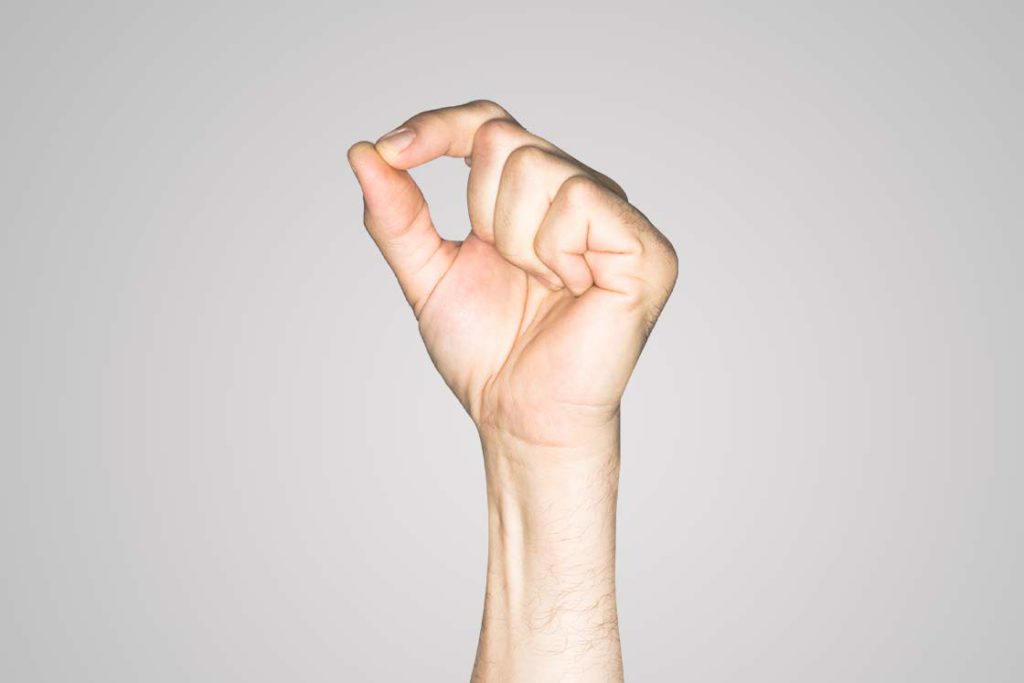
Chinmaya Mudra is also known as the ‘mudra of awareness’. Being a host of anxiety, it is common to lose track of normal life. This mudra draws the awareness to self that guides the practitioner on what is important and what’s not.
Practicing Chinmaya mudra during meditation calms the mind and the body. It opens the channels of positivity through the alignment of vital force at the subtle level. Ultimately, makes an individual enthusiastic in life.
How to do
- Come into any comfortable sitting posture Sukhasana (Simple Pose), Siddhasana (Accomplished Pose).
- Make a fist and free up the thumb and index finger. Touch tip of the index to the thumb or vice-versa.
- Maintain posture and practice for a few minutes.
To amplify the effectiveness of Chinmaya Mudra, it can be done along with the pranayama like Kapalbhati, Anulom Vilom, etc.
Benefits
- It energizes thoracic region.
- Overcome Insomnia.
- Enhance nervous functioning.
- Aids in digestion.
5. Gyan Mudra
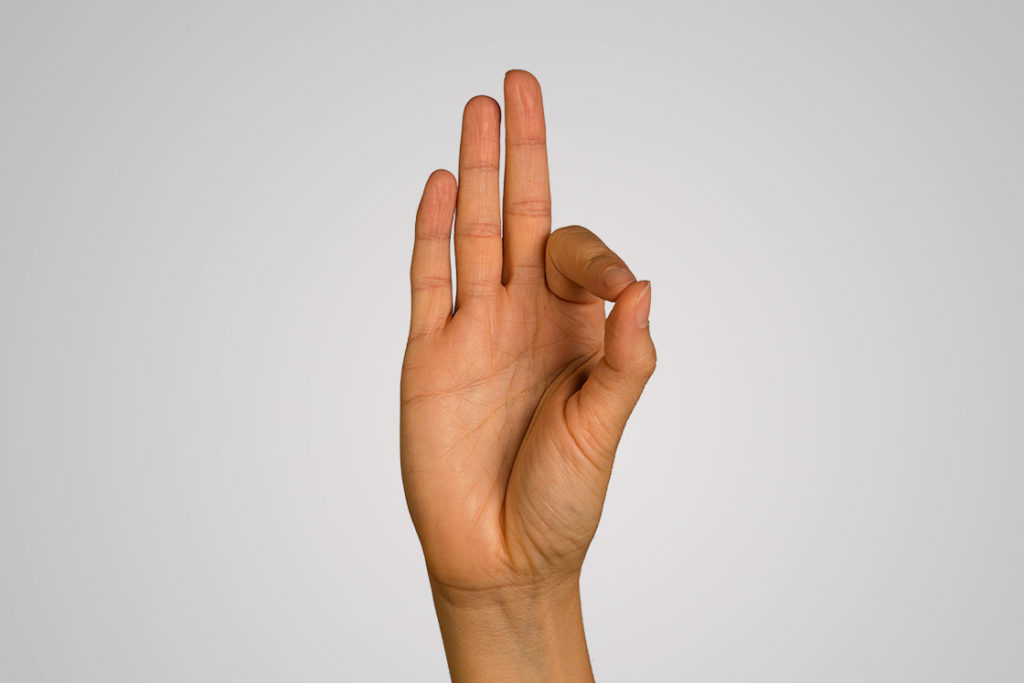
Also known as chin mudra, this mudra is a ‘seal of knowledge‘, as it is the belief that ancient yogis used to sit and meditate in this mudra. Anxiety can be due to the ‘Agyan or not knowingness’, like we perceive things differently, from what they actually are!
Meditation in Gyan mudra fills the practitioner with light (divine) that clears the darkness within. The air element ensures the better functioning of the nervous system. Hence, this mudra immunized the mind and the body as well.
How to do
- Begin by any sitting posture Padmasana (Lotus Pose).
- Now, touch the tip of the index and thumb finger to each other.
- Straighten up the remaining fingers. Maintain and practice it for a few breaths.
One can also practice it along with the meditation to make it more beneficial in achieving the necessary target. However, the practitioner can also experiment it with other simple asanas as well.
Benefits
- Helps in the stimulation of root chakra.
- Deepens concentration and improves memory.
- Incorporates calmness in personality.
- Promotes better functioning of the pituitary gland.
Integrating Mudras into Your Daily Routine
To maximize the benefits of mudras, consider incorporating them into your daily routine. Here are a few tips:
- Consistency is Key: Practice mudras regularly, ideally at the same time each day. Morning and evening sessions can be particularly effective.
- Combine with Meditation: Enhance the effects of mudras by combining them with meditation or mindfulness practices. Focus on your breath and the sensations in your hands.
- Be Patient: Like any practice, the benefits of mudras may take time to manifest. Be patient and persistent in your practice.
- Listen to Your Body: If you feel discomfort or strain while practicing a mudra, stop and adjust your hand position. Mudras should be comfortable and relaxing.
Conclusion
Anxiety is something that enlarges the picture, which is actually not, in the real world. Due to which people suffer panic attacks, rising heartbeat, and breathing. All these activities make our organ system to work in hyper condition and ultimately, damage the body.
Mudras are the seal or you can say our palms carry pressure points, which on pressing under right breathing and yogic posture, heals the condition of anxiety.
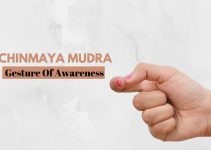
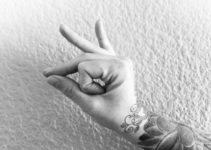


Thank you for sharing these powerful yoga mudras! I’ve been struggling with anxiety and am excited to try these techniques to help calm my mind. The detailed explanations are really helpful. Looking forward to incorporating them into my daily routine!
My god what a wonderful Relief and Effect that i got after doing this Mudra… Tq so much for providing me such a excellent information and details about mudra…
Dear Sir, Thanks for the five Mudras and the way to practice them. I am practising Gyan Mudra and Mushti Mudra since the last one month, now I can add others too.
Can you please advice what should be the length of time for each Mudra and whether they have to be practised one after the other or separately at different times,
Thank you once again.
Regards!
Asha Iyer
Hello, thank you for your comment! As for the length of time for each mudra, it’s generally recommended to start with 5-10 minutes per mudra and gradually increase the duration as you become more comfortable.
Regarding whether they should be practised one after the other or separately at different times, it really depends on your personal preference and schedule. Generally, it’s recommended, after practising one mudra keep a gap of at least 4 minutes before doing another to balance the effect of the first mudra.
I hope this helps, and happy practising!